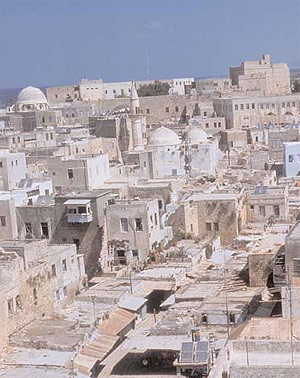

 |

|

Veduta panoramica della cittŕ di Akko |
Introductionby Boris BiancheriPresident of ANSA The idea of an exhibition that uses pictures to tells us what the countries of the Mediterranean, their cities, their people, their coasts and their ports were like a century or more ago and also, with a few more recent photographs, how all this has been transformed in time, is the result of a fortunate encounter.On the one hand we have the extraordinary photographic heritage of the Alinari Museum. On the other, the decision of ANSA to find, with the ANSA medproject, forms of timely and trustworthy communication between one Mediterranean country and another and between the Mediterranean countries and the rest of the world. And then, as bridge between the one and the other, we have the sensitivity to the problems of the Mediterranean shown by the Senate of the Republic of Italy and by its President with his desire to elucidate the importance this area has today not only for the Italians but for the international community as a whole. It is hard to define a Mediterranean identity in terms that are other than purely geographical. Rare indeed are the moments in history when a unifying coherent thread ran through the alternating fortunes of the coastal countries. The Mediterranean nations are inhabited by different ethnic groups, their peoples have different religions and they speak different languages. On the surface, there are more things that divide them than there are which unite them. Yet, anyone looking at the splendid Alinari Museum photographs selected for this exhibition cannot help but find, up to relatively recent years, a surprising number of elements they have in common. At first the common denominator seems to be nothing but the basic ochre tone or the affinity of the visual language of the man behind the lens – often moreover of Anglo- Saxon extraction. But soon one realizes that this is not the case, that these pictures testify to an unexpected aesthetic and civil relationship: look at the port of Marseilles and that of Algiers, look at the houses of La Valletta and those of Beirut, look at the streets of a Moroccan city and those of Naples and an indefinable but self-evident Mediterranean identity will strike the eye. Yet these pictures also lead to another consideration. There was more affinity along the Mediterranean shores a hundred years ago than there is now. The two great shores, above all, the European shore and the southern shore, shared features that have in great part been lost. In a certain sense the shores have drawn further apart. The melting-pot that existed when a prevalently agricultural and mercantile civilization existed throughout the entire Mediterranean area gradually disappeared with the advent of the industrial civilization and even more with that of today’s technological civilization. The feeling of belonging is still there, we can still perceive the bond that joins the countries of this sea, and politically and socially the need to give the region a sense of brotherhood as well as greater peace and stability is stronger than ever. But if all this is to be salvaged, a basic requisite is an ongoing dialogue that touches on the varied fields of human activity and helps them to develop concordantly in the countries of the region. ANSA, a primary source of information, is convinced that one of the first things to do in reconstituting this harmony is to pass on the news, so that everyone knows what their neighbour is doing and what is being done at the other end of this sea and that what happens here is also known elsewhere. This is what has prompted us to create ANSA med, an up-to-the-minute multilingual information service that every day of the year, 24 hours a day, relays, through over 100 daily news items, the political, economic, religious, cultural, sport and news reports in the various countries of the Mediterranean. It does so with the contribution of our offices in the world and in particular that of the many offices in the region as well as with the collaboration of the press agencies in the coastal countries. Now, imagine you are seated in a café in one of the ports to be seen in the fine Alinari photos, at the time when the photo was taken, or afterwards, in recent years, or even today, in these difficult and troubled times of ours. If you are seated at a table in a café in any whatsoever of these cities or in any whatsoever of these villages, you probably have a glass in front of you containing an anise-flavored liquid, for anise is a taste found all along the Mediterranean coasts. People come and people go, someone, maybe, will say something to you and might even sit down at your table; everyone has something to recount, what happened yesterday or what he hopes will happen tomorrow. Everyone, probably, has other things to do, but talking, giving and getting news is what matters most. After sitting there a while, you realize that the true identity of the Mediterranean is none other than this, the pleasure someone you never met has in talking with you and getting to know all about you. This is what we have attempted to do: to tell you with this exhibition what the Mediterranean was when encounters and trade were its driving force, what we were then, and to help you, now and in the future, to be so once again. |